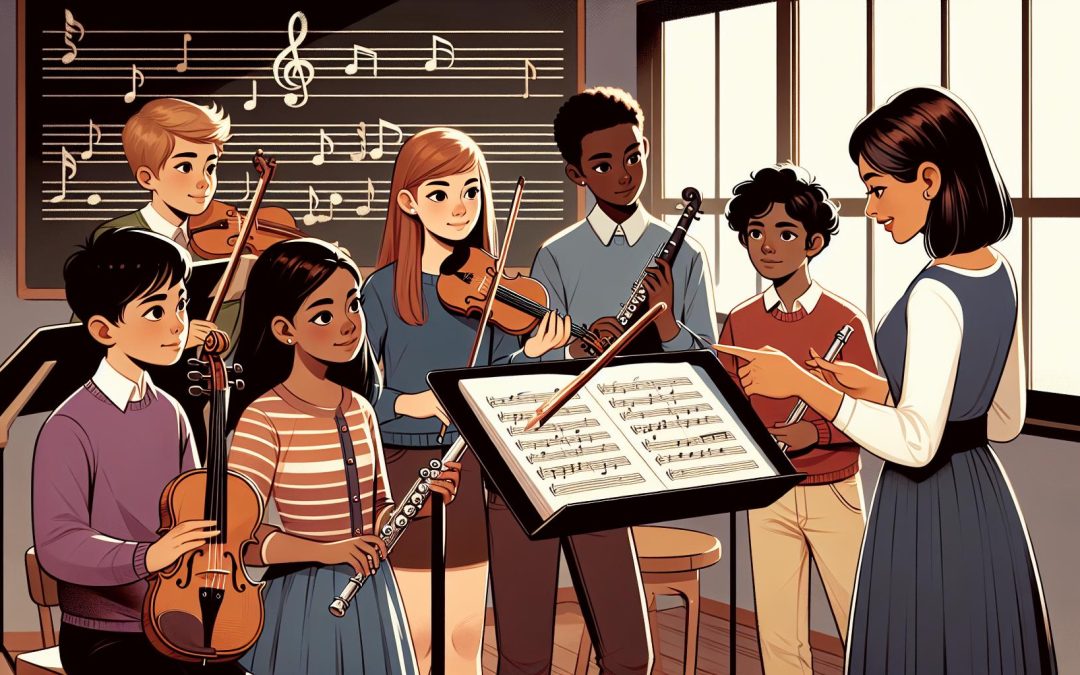Learning to read music can feel like cracking a secret code. For many budding musicians, the treble clef notes are where the adventure begins. But don't worry, there's no need to feel overwhelmed. With a few simple tricks up your sleeve, you'll be reading those notes as effortlessly as you read your favorite book.
Remembering the treble clef notes is all about finding fun and easy ways to anchor the information in your mind. Whether it's catchy phrases, visual aids, or clever mnemonics, there's a method that'll work for you. Let's dive into some of the most effective strategies to turn those daunting dots and lines into clear, musical messages.
Understanding the Treble Clef
The treble clef, also known as the G clef, plays a pivotal role in music notation as it sets the reference point for the notes on the staff. Recognizing its significance is the first step toward mastering the art of reading music. The treble clef symbol curves around the G line on the staff, indicating that this line represents the note G.
This notation system might seem daunting at first, but with a bit of practice, anyone can master it. The notes on the lines and spaces each carry specific pitches, and these are what musicians learn to recognize quickly to interpret music accurately.
Breaking Down the Treble Clef Notes
The notes on the lines from bottom to top are E, G, B, D, and F. A popular mnemonic to remember this order is "Every Good Boy Does Fine." For the spaces, the notes spell out the word FACE, starting from the bottom. This simple yet effective method makes remembering the position of notes easier and reading music more accessible.
Visual Aids and Mnemonics
Visual aids, like diagrams and charts, can significantly enhance understanding and memorization of the treble clef notes. They offer a visual representation of where each note sits on the staff, making it easier to grasp the spatial relationships between notes. Furthermore, creating personal mnemonics or phrases can add an element of fun to the learning process, ensuring that the information sticks.
The Role of Practice
Like any skill, practice plays a vital role in learning to read the treble clef notes efficiently. Initially, it's helpful to take time to study the staff and the placement of each note, using the mnemonics and visual aids as guides. Gradually, identifying the notes will become second nature, enhancing the ability to read music fluently.
Incorporating flashcards, music apps, or even simple quizzes can transform practice sessions into engaging and interactive learning experiences. They not only reinforce memory but also add variety to avoid monotony.
Applying Knowledge Through Music
Once the basic understanding of the treble clef notes is established, applying this knowledge through actual music can be highly rewarding. Starting with simple melodies that use a limited range of notes can help solidify this new skill. As confidence grows, gradually expanding into more complex pieces will further develop music reading capabilities.
Importance of Learning Treble Clef Notes

The treble clef serves as a critical element in the world of music, marking the very beginning of one's musical journey. When someone learns to interpret the symbols swirling on the lines and spaces of the treble clef, they unlock a universal language shared by musicians worldwide. This knowledge not only opens doors to various genres of music but also enables individuals to communicate their musical ideas effectively.
At its core, mastering the treble clef notes nurtures a solid understanding of music theory. Knowing the precise location of each note is crucial for reading and writing music accurately. This foundational knowledge allows musicians to progress from simple melodies to intricate compositions with confidence. The ability to swiftly recognize notes on the treble clef enhances sight-reading skills, making it easier for musicians to explore new pieces independently.
Beyond the technical necessity, there's a beautiful reason to immerse oneself in the study of treble clef notes; it fosters a deeper connection with the music. Musicians often express that their appreciation for music flourishes as they delve more into its structure and notation. Learning the treble clef is not just about memorizing where the notes lie; it's about understanding the harmony and rhythm that come to life when those notes are played in sequence.
Interactive tools play a pivotal role in this learning process. Incorporating flashcards, mobile apps, and online games into practice sessions can make the experience more engaging and enjoyable. These resources cater to different learning styles, ensuring that everyone can find a method that resonates with them.
Musicians who invest time in mastering the treble clef often find that they're not just learning to read notes—they're learning to speak the language of music fluently. This opens up a world of possibilities, from composing original pieces to interpreting the works of famous composers with nuance and depth.
Common Mnemonics for Remembering Treble Clef Notes

Memorizing the notes on the treble clef can seem daunting at first. However, educators and musicians have long used mnemonic devices to simplify this task. A mnemonic is a tool that helps us remember information easier, often by associating that information with a memorable phrase or pattern. When it comes to music, mnemonics can turn the challenge of remembering notes into an engaging and effective learning activity.
One of the most popular mnemonics for the lines of the treble clef spells out EGBDF. Music students often learn the phrase, "Every Good Boy Does Fine," to remember the order of these notes from bottom to top. For the spaces, which spell out FACE, no phrase is necessary; it's already a word! This simple wordplay makes it easier for learners to recall which notes fall where on the staff.
Beyond these basics, creative educators sometimes develop unique phrases to align with their students' interests or humor. For example:
- "Every Great Band Draws Fans" could resonate more with those interested in contemporary music.
- "Elephants Go Bouncing Down Freeways" might appeal to younger students with vivid imaginations.
These mnemonic devices not only aid in memorization but also add a bit of fun to the learning process. It's important, however, to remember that while mnemonics are incredibly helpful, practice is key to solidifying this knowledge. Incorporating games, flashcards, and writing exercises that use these mnemonics can further enhance a student's ability to quickly and accurately identify treble clef notes.
In addition to traditional mnemonics, technology offers new ways to learn. Mobile apps and online tools often integrate mnemonic-based games to teach musical notes. These platforms can provide immediate feedback and adapt to a user's learning pace, making music education both accessible and personalized.
By combining mnemonics with regular practice and modern learning tools, students can overcome initial hurdles in reading music. This approach not only simplifies the process of learning treble clef notes but also nurtures a lasting appreciation for music theory and literacy.
Using Visual Aids to Memorize Treble Clef Notes

Incorporating visual aids into the learning process can significantly boost a student's ability to memorize treble clef notes. From flashcards to colorful charts, these tools use the power of imagery to imprint musical symbols in the mind. Many educators find that when students physically see the notes in relation to the treble clef, their understanding of music notation strengthens.
Flashcards are a tried-and-true method, valuable for their portability and ease of use. They can feature the note on the staff on one side and the note name on the other, encouraging self-testing and repetition. Innovative teachers might also include mnemonic devices on the flashcards, combining visual learning with verbal memory aids.
Another effective visual tool is the use of color-coded charts or diagrams. Assigning a distinct color to each note or line can help students visually differentiate between them. For example, coloring all "E" notes in red and "G" notes in blue helps students quickly recognize the note's position on the staff. This method becomes especially helpful when learning sheet music, as the colors can serve as instant reminders of each note’s identity.
Interactive software and apps take visual learning a step further by integrating engaging activities and games that adapt to a student’s learning pace. These programs often feature a virtual treble clef staff where notes move across the screen, and the student identifies them in real-time. Such technology not only reinforces note recognition but also keeps the learning process engaging and fun.
Moreover, educators sometimes employ creative projects like crafting a model of the treble clef with notes positioned accurately. Students can use everyday items or craft materials to create these models, further reinforcing their understanding of note placement in a hands-on manner.
Visual aids are not just supplementary tools; they are fundamental in making the study of music theory more accessible and enjoyable. By transforming abstract notes into tangible, colorful, and interactive experiences, students find themselves more engaged and motivated. The beauty of these visual tools lies in their versatility — they can be tailored to fit any learning style, ensuring that every student has the opportunity to excel in music theory.
Practice Exercises to Solidify Treble Clef Note Recognition

Incorporating practice exercises into a student's study routine is crucial for reinforcing treble clef note recognition. These activities not only consolidate what's been learned visually but also add a fun and interactive dimension to the learning process.
One highly effective exercise involves the use of note naming worksheets. Students are presented with sheets filled with various notes on the treble clef staff, and their task is to write the corresponding letter names beneath each note. Initially, students might find this challenging, but with consistent practice, they'll quickly improve. Teachers can gradually increase the difficulty by adding ledger lines above and below the staff.
Another exciting exercise is "Name That Tune." Here, educators play simple melodies or note sequences on an instrument and ask students to identify and name the notes played. This auditory exercise enhances students' ability to connect what they see on the page with the sounds they hear, solidifying their understanding of music notation.
For a more interactive approach, incorporating music theory games and apps can be remarkably effective. Many of these digital tools are designed to make learning engaging, with progress trackers, levels, and challenges that motivate students to improve. Some popular apps include Staff Wars, Note Rush, and Music Theory Pro.
Group activities also offer valuable practice opportunities. Teachers can organize students into small groups, where they're given a set of notes to arrange into a melodious sequence or even compose a simple piece together. This not only enhances their understanding of treble clef notes but also fosters teamwork and creativity.
To ensure steady progress, here's a suggested practice routine:
- Daily: Note naming worksheets for 10-15 minutes.
- Twice a Week: "Name That Tune" or similar auditory recognition activities.
- Weekly: Dedicate one session to interactive software or app-based learning.
- Monthly: Engage in a group activity to create a melody or piece of music.
| Activity Type | Frequency | Duration |
|---|---|---|
| Note Naming Worksheets | Daily | 10-15 minutes |
| Auditory Recognition | Twice a Week | Varies |
| App-Based Learning | Weekly | Session-based |
| Group Activities | Monthly | Varies |
Conclusion
Mastering the treble clef notes doesn't have to be a solo journey filled with monotonous drills. By weaving together interactive exercises, innovative apps, and the power of group dynamics, students can transform their learning experience into an enjoyable adventure. It's all about finding the right mix of technology, teamwork, and consistent practice. With the strategies outlined, learners are well-equipped to navigate the musical staves with confidence and creativity. Let's make music theory a vibrant part of every musician's journey.
Harlan Kilstein began playing piano during covid with no piano background at all. He taught himself how to play learning what to do and what not to do.
Today he's an advanced intermediate player and can help you grow in your skills because he learned all this on his own.







